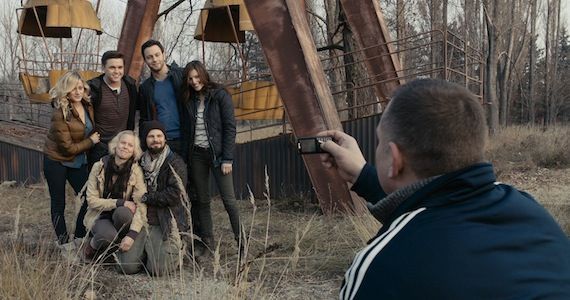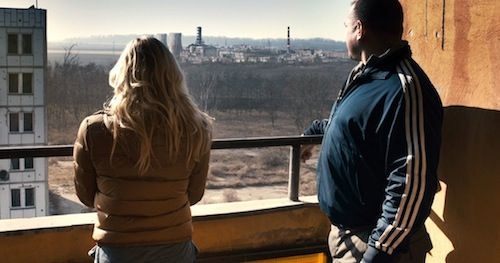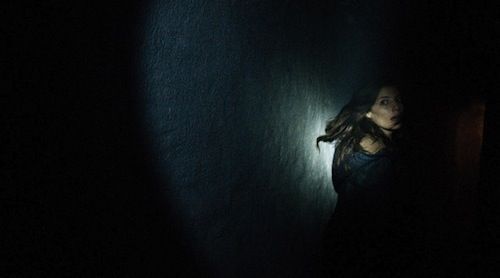Chernobyl Diaries is caught in an unsatisfying middle ground between traditional horror tropes.
At first glance, many moviegoers will assume that Chernobyl Diaries is just the latest entry in the found-footage genre - considering the film's trailer is chock-full of awkward shaky cam footage (the movie is also based on a story by Oren Peli, creator of the Paranormal Activity franchise). Despite Peli's involvement as creator and producer (Bradley Parker directs), Chernobyl Diaries is actually a much more standard horror project - featuring known actors (including musician Jesse McCartney as well as Jonathan Sadowski from S#*! My Dad Says) and an omniscient camera that follows a group of friends as they enter a restricted area and subsequently get picked off one at a time by mysterious inhabitants.
Without the found footage craze to fall back on, does the eerie Chernobyl backdrop and Peli-conceived story, coupled with the choice of shaky cam footage, make Chernobyl Diaries a memorable horror outing?
Unfortunately, Chernobyl Diaries is caught in an unsatisfying middle ground between traditional horror tropes and (as alluded to earlier) a number of filmmaking choices borrowed from Peli's found footage repertoire. As mentioned, the film is not a found footage project, but it has all of that genre's shortcomings (shaky camera work and an underdeveloped overarching plot to name a few) which essentially undercut any potential enjoyment that could have been derived from the admittedly engrossing setting and premise. While a certain batch of moviegoers might enjoy the film's frantic shooting style, many audiences will recognize the shaky cam for what it actually is - an excuse to ratchet up tension in an otherwise thin and underwhelming trip through increasingly dark corridors.
The initial story foundation is pretty basic: a group of American tourists - Chris (McCartney), Natalie (Olivia Taylor Dudley), Amanda (Devin Kelley) and Paul (Sadowski) - sign-up for an "extreme tourism" adventure to Pripyat, a Ukrainian city that was built to house Chernobyl nuclear power plant employees (also featured in the first act of Transformers: Dark of the Moon). Long abandoned, following the catastrophic nuclear accident at Chernobyl, the city has been reclaimed by nature - following the exodus of nearly 50,000 evacuees who were forced to leave their homes at a moment's notice. When the tourists first arrive at the site - along with tour guide Uri (Dimitri Diatchenko) and a backpacking couple, Michael (Nathan Phillips) and Zoe (Ingrid Bolsø Berdal) - the group is turned away at a checkpoint by military officials. Undeterred, Uri finds a back way into Pripyat - and the tourists spend the day exploring the post-apocalyptic compound. However, when it's time to leave, Uri's van fails to start and the group is thrust into a life-or-death struggle for survival against wild animals and a mysterious presence that moves among the irradiated ruins.
The early moments of the film (establishing the various character dynamics) are pretty stilted (as are the performances throughout) but once the group arrives at Pripyat, it's easy to get engrossed in the setting - as the abandoned city (which was actually shot on location) offers a creepy but extremely fascinating backdrop for the on-screen drama. That said, as the "horror" elements are pushed to the fore, the film mostly abandons the bizarre on-site visuals (such as a rusted ferris wheel and parking lot full of corroded vehicles) in favor of dark underground hallways. Coupled with the shaky cam footage, the filmmakers essentially strip away the one aspect that made the film stand out from similar horror offerings - and the experience devolves into a frustrating and nauseating mess that fails to deliver a satisfying payoff (neither in terms of narrative beats or "creature" reveals).
At nearly every turn, Chernobyl Diaries presents story ideas and reveals in order to get a reaction out of the audience - not because any of them tie together or make sense by the time the credits roll. While "character development" is hardly a concern in the film, most audiences will find the various decisions and actions taken by the characters to be especially hard to swallow, or at the very least, obviously motivated by the filmmaker's effort to push the group further and deeper into the belly of Pripyat - instead of as far away from danger as possible. Moviegoers expect to suspend a certain amount of disbelief while in a theater, especially in the horror genre, but aside from the compelling setting, Chernobyl Diaries presents one formulaic set-piece after another - always prioritizing spooky set-ups over telling a fully-formed story (which becomes increasingly hard to swallow in the third act). As a result, the strung-together series of scares fails to provide compelling answers to the Pripyat mystery as well as entirely forgoes a satisfying closure to more than one key character.
Considering there's no "character" behind the film's wobbly camera, as the story progresses and the mystery begins to unravel, it becomes painfully obvious that the shaky cam work is being used to compensate for what could be one of the least compelling and underdeveloped "horror" reveals of all time. By flailing the camera around, the film manages to stretch out a pretty boring (and completely unearned) idea that, had Chernobyl Diaries been shot with a steady cam instead, would have otherwise had audiences rolling their eyes in the second act.
All of these missteps could be forgivable if the film delivered entertaining scares or tense encounters, but other than a few traditional "what's under that sheet" scenes of "horror," there are very few surprises or intriguing developments to justify the poorly realized filmmaking ideas. It's too bad because, in the hands of a more ambitious team of moviemakers, Peli's core idea could have been stretched into an extremely interesting mystery drama. Instead, as each layer of the "horror" is pulled back, the Chernobyl Diaries experience is less and less captivating - all while becoming increasingly convoluted.
By the end, Chernobyl Diaries presents a mismatched effort that was working with some intriguing core elements (namely the location and primary, albeit underdeveloped, storyline) - which are undermined by the film's unsatisfying cinematography and reliance on worn-out recreations of familiar horror set-ups. That said, if there's one thing the film does right (note: it's not the horror), it's that Chernobyl Diaries will likely fascinate viewers with the real life Pripyat story - hopefully resulting in an increased viewership for a number of documentaries that have explored the abandoned city in greater detail.
If you’re still on the fence about Chernobyl Diaries, check out the trailer below:
-
[poll id="325"]
-
Let us know what you thought of the film in the comment section below.
Follow me on Twitter @benkendrick for future reviews, as well as movie, TV, and gaming news.
Chernobyl Diaries is rated R for violence, some bloody images and pervasive language. Now playing in theaters.



